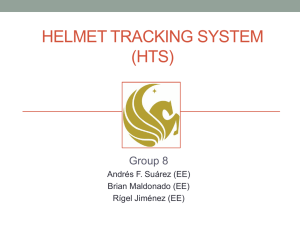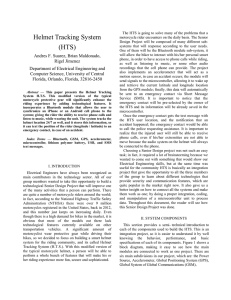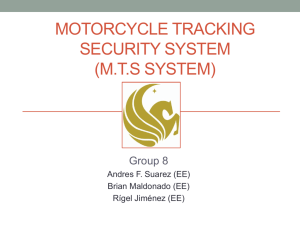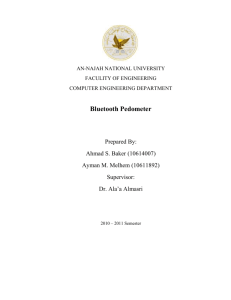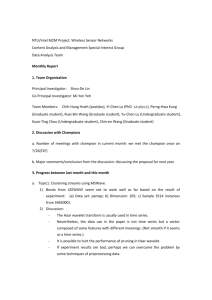Helmet Tracking System (HTS)
advertisement
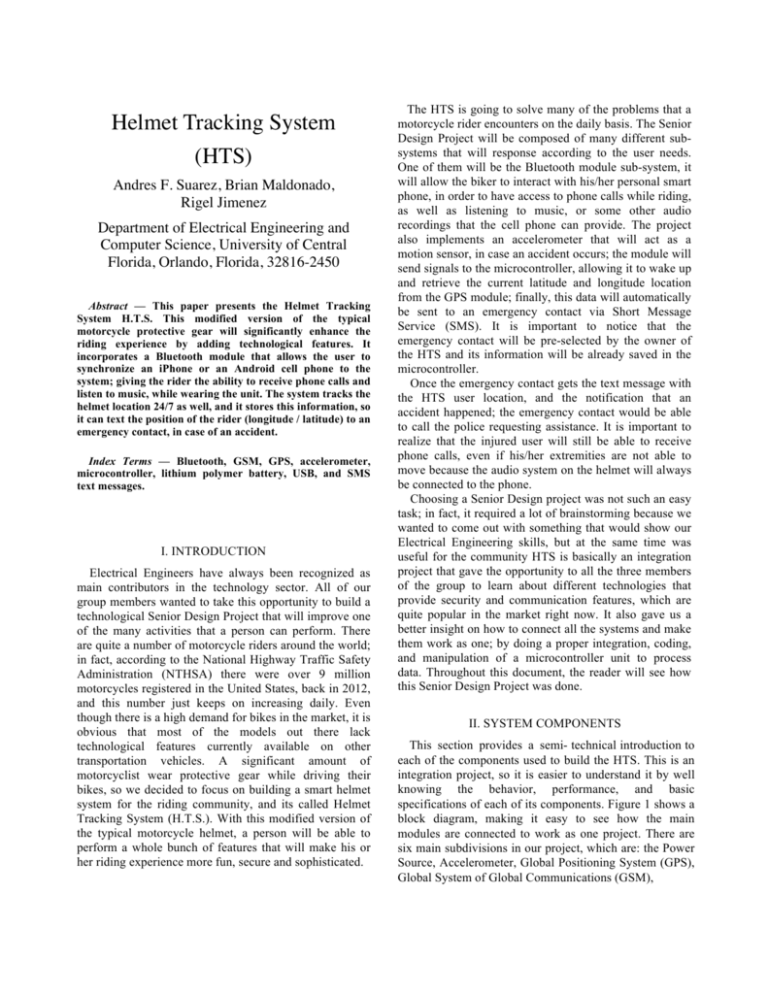
Helmet Tracking System (HTS) Andres F. Suarez, Brian Maldonado, Rigel Jimenez Department of Electrical Engineering and Computer Science, University of Central Florida, Orlando, Florida, 32816-2450 Abstract — This paper presents the Helmet Tracking System H.T.S. This modified version of the typical motorcycle protective gear will significantly enhance the riding experience by adding technological features. It incorporates a Bluetooth module that allows the user to synchronize an iPhone or an Android cell phone to the system; giving the rider the ability to receive phone calls and listen to music, while wearing the unit. The system tracks the helmet location 24/7 as well, and it stores this information, so it can text the position of the rider (longitude / latitude) to an emergency contact, in case of an accident. Index Terms — Bluetooth, GSM, GPS, accelerometer, microcontroller, lithium polymer battery, USB, and SMS text messages. I. INTRODUCTION Electrical Engineers have always been recognized as main contributors in the technology sector. All of our group members wanted to take this opportunity to build a technological Senior Design Project that will improve one of the many activities that a person can perform. There are quite a number of motorcycle riders around the world; in fact, according to the National Highway Traffic Safety Administration (NTHSA) there were over 9 million motorcycles registered in the United States, back in 2012, and this number just keeps on increasing daily. Even though there is a high demand for bikes in the market, it is obvious that most of the models out there lack technological features currently available on other transportation vehicles. A significant amount of motorcyclist wear protective gear while driving their bikes, so we decided to focus on building a smart helmet system for the riding community, and its called Helmet Tracking System (H.T.S.). With this modified version of the typical motorcycle helmet, a person will be able to perform a whole bunch of features that will make his or her riding experience more fun, secure and sophisticated. The HTS is going to solve many of the problems that a motorcycle rider encounters on the daily basis. The Senior Design Project will be composed of many different subsystems that will response according to the user needs. One of them will be the Bluetooth module sub-system, it will allow the biker to interact with his/her personal smart phone, in order to have access to phone calls while riding, as well as listening to music, or some other audio recordings that the cell phone can provide. The project also implements an accelerometer that will act as a motion sensor, in case an accident occurs; the module will send signals to the microcontroller, allowing it to wake up and retrieve the current latitude and longitude location from the GPS module; finally, this data will automatically be sent to an emergency contact via Short Message Service (SMS). It is important to notice that the emergency contact will be pre-selected by the owner of the HTS and its information will be already saved in the microcontroller. Once the emergency contact gets the text message with the HTS user location, and the notification that an accident happened; the emergency contact would be able to call the police requesting assistance. It is important to realize that the injured user will still be able to receive phone calls, even if his/her extremities are not able to move because the audio system on the helmet will always be connected to the phone. Choosing a Senior Design project was not such an easy task; in fact, it required a lot of brainstorming because we wanted to come out with something that would show our Electrical Engineering skills, but at the same time was useful for the community HTS is basically an integration project that gave the opportunity to all the three members of the group to learn about different technologies that provide security and communication features, which are quite popular in the market right now. It also gave us a better insight on how to connect all the systems and make them work as one; by doing a proper integration, coding, and manipulation of a microcontroller unit to process data. Throughout this document, the reader will see how this Senior Design Project was done. II. SYSTEM COMPONENTS This section provides a semi- technical introduction to each of the components used to build the HTS. This is an integration project, so it is easier to understand it by well knowing the behavior, performance, and basic specifications of each of its components. Figure 1 shows a block diagram, making it easy to see how the main modules are connected to work as one project. There are six main subdivisions in our project, which are: the Power Source, Accelerometer, Global Positioning System (GPS), Global System of Global Communications (GSM), Figure 1. HTS Block Diagram Bluetooth module connected to headphones and microphone, and finally the Microcontroller unit that brings all the components together. A. Microcontroller Finding the most adequate central processing unit for the HTS was one of our main concerns; therefore, lots of time was put into researching our options when it came to microcontrollers. While some had too much power or pins, others just simply did not; some of the microcontroller units that we took into consideration were the Texas Instruments MSP430 and some of the ATmega units done by the company Atmel. As far as finding a neutral balance, it was not too difficult to run into. Eventually, our group decided to go with one of the Atmel microcontrollers, the one selected was the ATmega 328. This microcontroller unit was mainly chosen because it has a good amount of A/D and digital I/O pins, decent memory, clock speed and fits right in overall with our design specifications. With multiple UART and SPI interfaces and one I2C, it is compatible with ever device we are using in our design. The table 1 shows it main features. FEATURES 1.8-5.5V Operating Range Up to 20MHz processing speed 32kB Flash Memory & 1kB EEPROM 2kB Internal SRAM 8 Channel 10-bit ADC Serial USART/SPI/2-wire I2C Interface 16 MHz of Clock Speed 23 IO lines Table 1. Atmel ATmega328 Main Features Atmel features a familiar C language with some easy to use functions, which fit perfectly for our project; and that is one of the reasons why it was selected. The group was also looking to have as much support as possible with the microcontroller community and using this microcontroller automatically gives an advantage when it comes to finding information, not to mention all the forums that are available online to ask questions regarding the compatibility and quirks any of the modules might have once they are connected to the microcontroller unit. B. Accelerometer The accelerometer is one of the main components of the HTS. An accelerometer is a special sensor that can detect accelerations and decelerations in any axis, depending of course on what that certain accelerometer is capable of. In this project, the module will be given two main functions, first to act as a motion sensor, and second to detect possible accidents. The accelerometer is going to be implemented to help the HTS detect a crash. Since one of the abilities of an accelerometer is to pick up decelerations, that can be used to detect any sudden high decelerations that are indicative of an accident. This will be part of the safety system that will help the motorcyclist get a quicker response for help during an emergency, since motorcycle accidents can be deadly. Most of the time motorcyclists are by themselves and if by some chance they get in an accident with no one around how will they call for help? With this feature they can feel more at ease about that possibility since the safety system can call for them. The accelerometer will have a certain threshold that once the amount of deceleration or g-force passes it, it will trigger the safety system, which will then send a SMS with coordinates of the accident location. With all this information the emergency contact will be able to get in contact with the user, and also look for help. After doing our research we found out that to be as accurate as possible using a three-axis accelerometer would be the best choice; since there are many factors to be accounted using a two-axis accelerometer would be a little inaccurate. The module incorporated in the HTS is the ADXL345; Figure 2 below shows its schematic. Figure 2. ADXL345 Accelerometer Module Schematic Having a three axis will help be more accurate in calculating the g-forces in an accident, which is very important for the safety of the rider. The Table 2 below shows some other basic features that the ADXL345 has the ability to offer. FEATURES Voltage Supply 1.8V to 3.6V Current Consumption 25 to 130µA at 2.5V Resolution 10-bit at every g-range Serial Communication SPI or I²C Sensitivity ±2g 3.9mg/LSB, ±4g 7.8mg/LSB, ±8g 15.6mg/LSB, ±16g 31.2mg/LSB Number of Axes 3-Axis Dimension 3mm x 5mm x 1mm Table 2. Accelerometer ADXL345 Features C. GPS For our project, we need to know the location of the motorcycle rider at all the time; this information is fundamental for the HTS because it will need to be sent to the emergency contact in case a crash occurs. During an accident a person can get injured, and might not be able to call for help, so the HTS will automatically send a SMS text message with the biker’s location. In order to keep track of the location of the HTS the group decided to select the Global Positioning System (GPS) module LS20031 done by Locosys; which is fully compatible with the chosen microcontroller unit. The LS20031 module is a complete GPS smart antenna receiver that includes an embedded antenna and GPS receiver circuits. This low-cost unit outputs an astounding amount of position information 5 times a second. The receiver is based on the proven technology found in LOCOSYS 66 channel GPS SMD type receivers that use MediaTek chip solution. This well-rounded GPS module met all the requirements needed for the HTS; Table 3 shows its main features. Another key factor that we took into consideration is the kind of information that the GPS receiver provides. The LS20031 module provides NMEA (National Marine Electronic Association) massages as output, so we had to manipulate this data using the Arduino environment to provide the latitude and longitude of the motorcyclist in its standard form. FEATURES 66 Channel – 5 Hz GPS Receiver 57600 bps TTL serial interface (baud rate) Operating Voltage = 3.3 V at 41 mA Fast Time to first fix at low signals LED indicator for fix or no fix Acquisition Time : Cold Start 35 s Hot Start < 2s Dimensions: 30 x 30 mm Position Accuracy: 2.5 to 3 m Table 3. LS20031 GPS Module Features D. GSM This senior design project implements a Global System of Mobile Communications (GSM) technology. The realization of GSM is essential because it allows us to have access to a mobile communications network. The Helmet Tracking System uses this module to access a cellular network that offers text-messaging services. Figure 3 below shows a functional block diagram of the selected module and its dimensions. The GSM Module SM5100B offers a wide variety of applications, it can be use to make phone calls, send messages and so on. But, we are only going to use to send emergency messages, we do not need it to make phone calls because the H.T.S has the ability to synchronize to a cell phone via Bluetooth, and it will use the cell phone to call people. The module requires the use of a SIM card to connect to the network, we decided to use a standard size SIM card socket for our PCB design, and we are using the T-mobile network for text messaging, other networks such as AT&T can also be used by modifying the software. The GPS module included in the H.T.S utilizes a Short Message Service (SMS) to implement text messaging; we agreed on implement SMS because it uses standardized communication protocols that allow the exchange of short text messages between a fixed line or mobile phone devices. The GSM module SM5100B can send messages that have up to 150 characters, which is enough for the purposes of our project; so of its other main features can be found on the table below. It is important to notice that the H.T.S is set up to send the SMS message to only one Emergency Contact that is pre-selected and added to the code of the system; as far as making calls, there are no limitations because the H.T.S will use the network of the external cell phone that is connected to the Bluetooth module. FEATURES Power: 3.3 – 4.2 V. Nominal 3.6 V Current consumption: off <100µA when module is and 2 mA in Sleep mode. Dimensions: 35.0 x 39.0 x 2.9mm Quad-band GSM. Frequency Bands: 900,850,1800,1900 MHz. Supports SIM (Auto Recognize) Supports UART interfaces Soldered connection for antenna and LED to notify network status Table 4. GSM Module SM5100B Features Figure 3. SM5100B GSM Module Block Diagram E. BLUETOOTH One of the features of the HTS has the ability to synchronize to a cell phone, in order to listen to music and receive phone calls. The HTS is able to synch to the two most popular cell phone devices (iPhone, and Android) and this is thanks to the Audio Bluetooth module that we selected. To transfer data between the HTS and a cell phone, wireless communication has to be used; the tricky part was to select the right one because there are a numerous amount of option in the market. Table 5 summarizes some of the technologies that caught our attention the most. Wi-Fi Data rate Bluetooth ZigBee 54Mb/s 3Mb/s Range 100m Class 1=100m Class 2 = 10m Class 3 = 1m 100m Networking Topology Point to Hub Ad-Hoc AdHoc/PTP /Mesh Operating Frequency 2.4GHz 2.4GHz 2.4GHz Power Consumption High Medium Very Low 3-5s <10s 30ms Network Acquisition Time There are a wide range of Bluetooth modules available in the market, due to the high popularity of this technology. Eventually, we picked out the RN-52 Audio Module, illustrated in Figure 4. 240 Kb/s Figure 4. RN-52 Audio Bluetooth Module The RN-52 fit the HTS perfectly, this is a Bluetooth Class 2 module that offers a range of 10 meters, which is more than enough distance to have between the motorcycle helmet and the cell phone that is usually carried by the motorcyclist on his or her pocket or backpack, and it also offers audio capabilities that not all the Bluetooth modules can provide. Table 6 below shows more features. FEATURES Supplied voltage: 3.0 ~ 3.6 V DC Class 2 Bluetooth - Version 3.0 Table 5. Wireless Communication Technologies Frequency band: 2.4 ~ 2.48 GHz Wi-Fi, Bluetooth, and ZigBee RF are technologies and modules that are quite popular when it comes to electrical engineering designs that required the use of wireless communications; as you can see from the table above they have similar features when it comes to range and operating frequency. Finally, we decided to go with Bluetooth Technology for our project because it met the requirements for the HTS it is quite popular in the market, and the cell phones that we are using to synchronize to our system, already have this technology incorporated in them, making the connection, and pairing between the cell phone and the HTS so much easier, fast, and effective. Maximum Data Rate: 3Mbps Embedded Stack Profiles: A2DP, AVRCP UART console interfaces Dimensions: 26.0 x 13.5 x 2.7 mm Table 6. RN-52 Bluetooth Module Features F. POWER SOURCE III. SOFTWARE DETAIL The HTS is composed by all the parts mentions above, and some other minor components such as Voltage Regulators, audio jacks, and so on. After analyzing the power consumption of all the components, we selected the Ultralife Lithium-Ion Battery – 1800 mAh to be the power supplier for our project. Table 7 below shows the power consumption of the modules previously described. Helmet Modules Power Consumption Modules Active mode Sleep mode ADXL345 145 µA 40 µA SM5100B GSM/GPRS 400 mA 2mA LS20031 GPS 29 mA 2mA ATmega328p 0.3 mA 0.8 µA Table 7. Helmet Modules Power consumption The Ultralife Lithium-Ion Battery – 1800 mAh is commonly used in portable electronics and tracking applications, so it was a perfect match for the HTS S. The battery average voltage is 3.7 V, and it has a capacity of 1.8 Ah; it is also known for its high energy density, which is 146 Wh/kg. The size of this unit, it is also beneficial to our project; the Lithium-Ion battery 1800 mAh is able to efficiently supply power to the HTS, while keeping a reasonable weight of 46 g, so it is quite light weighted. The HTS is a Senior Design project based on integration of electronic modules. To achieve an accurate and effective connection between all the modules, so they can work as one, the implementation of Software design was required. The Atmel ATmega328 was programmed used the Arduino UNO developing board. Arduino uses a C language like environment that is complemented by libraries that offer different functions. All of our group members are Electrical Engineering students; therefore, we found easier to program with this environment that offered a lot of support online. Figure 6 shows a flowchart explaining how the HTS behaves when an accident occur. The Bluetooth is the only module that is connected to the microcontroller, but is independent of the other modules to operate. Accelerometer • Threshold passed • Sends Interrupt to Microcontroller Microcontroller • Wakes up GPS, GSM to full active mode GPS • Retrieves location and sent to the microcontroller Decode • Micro decodes NMAE packet into latitude and Longitude GSM • Receives coordinates • Sends SMS to Emergency Contact Figure 5. Lithium Ion Battery Figure 6. Flowchart with HTS operational behavior IV. BOARD DESIGN When contemplating the board design it was clear that we only wanted to use one PCB because a typical motorcycle helmet is not that spacious. This PCB contains all the modules that make part of the Helmet Tracking System, while keeping a reasonable size of 3.39 in X 3.08 in. The Printed Circuit Board (PCB) is mounted on the rear part of the Helmet, and from there it interacts with the external peripherals that make part of the project. Figure 7, shown in the following page, illustrates the Schematics used in the PCB design. IV. CONCLUSION The HTS was a collaborative effort in designing a product that would test the group’s knowledge and challenge all its members. Figure 9. HTS PCB design schematics The goal of the project is to significantly enhance the motorcycle riding experience by adding technological features to the standard motorcycle protective gear. A motorcyclist does not have access to some features available in other transportation vehicles; but thanks to the H.T.S, the rider has the ability to synchronize his or her personal cell phone to the H.T.S to listen to music, and receive phone calls. This project also improves the quality of the riding experience by offering the ability to automatically message an emergency contact, in case of an accident. The items included into the device are a GPS module, a GSM module, an accelerometer and a Bluetooth module; and the microcontroller unit controls them all. These devices give information about the rider’s location, send SMS messages., and the wireless communication system provides entertainment features that are available to the user while the helmet is being used. ACKNOWLEGMENT The authors wish to acknowledge the assistance and support of Dr. Samuel Richie, Electrical Engineering Undergraduate Program Coordinator. THE ENGINEERS Andres F. Suarez is currently a senior at the University of Central Florida. He plans to graduate with his Bachelor’s of Science in Electrical Engineering in August of 2013. He plans to pursue a working career in electrical engineering after he graduates; and after getting a few years of experience on the field will go back to get his Master degree on Electrical Engineering or Business Administration. Brian Maldonado is currently a senior at the University of Central Florida. He plans to graduate with his Bachelor’s of Science in Electrical Engineering on August 2013. He plans to pursue a career utilizing his knowledge of electronics and control systems. He wants to gain the experience to further specialize his knowledge REFERENCES [1] Arduino, Website: http://www.arduino.cc [2] Roving Networks, Website: http://dlnmh9ip6v2uc.cloudfront.net/datasheets/Wireless/B luetooth/rn-52-ds-1.1r.pdf [3] Accelerometer Datasheet Sparkfun, Website: https://www.sparkfun.com/datasheets/Components/SMD/a dxl335.pdf [4] GSM Datasheet Sparkfun, Website: https://www.sparkfun.com/datasheets/Cellular%20Module s/CEL-09533-User's%20Manual.pdf [5] GPS Datasheet Sparkfun, Website: https://www.sparkfun.com/datasheets/GPS/Modules/LS20 030~3_datasheet_v1.2.pdf [6] Code-42, Website: http://www.code-42.blogstop.com/2011/01/li-po-batteriesexplained.html [7] Diagnosticnews, Website: http://www.diagnosticnews.com/featured/parasitic-batterydrains/ [8] Dimensioning-Engineering, Website: http://www.dimensionengineering.com/info/accelerometer s [9] Analog Devices, Website: http://www.analog.com/en/content/td_accelerometer_speci fications_definitions/fca.html [10] Battery University, Website: http://batteryuniversity.com/learn/article/understanding_lit hium_ion Rigel Jimenez is currently a senior at the University of Central Florida. He plans to graduate with his Bachelor’s of Science in Electrical Engineering in August of 2013.
